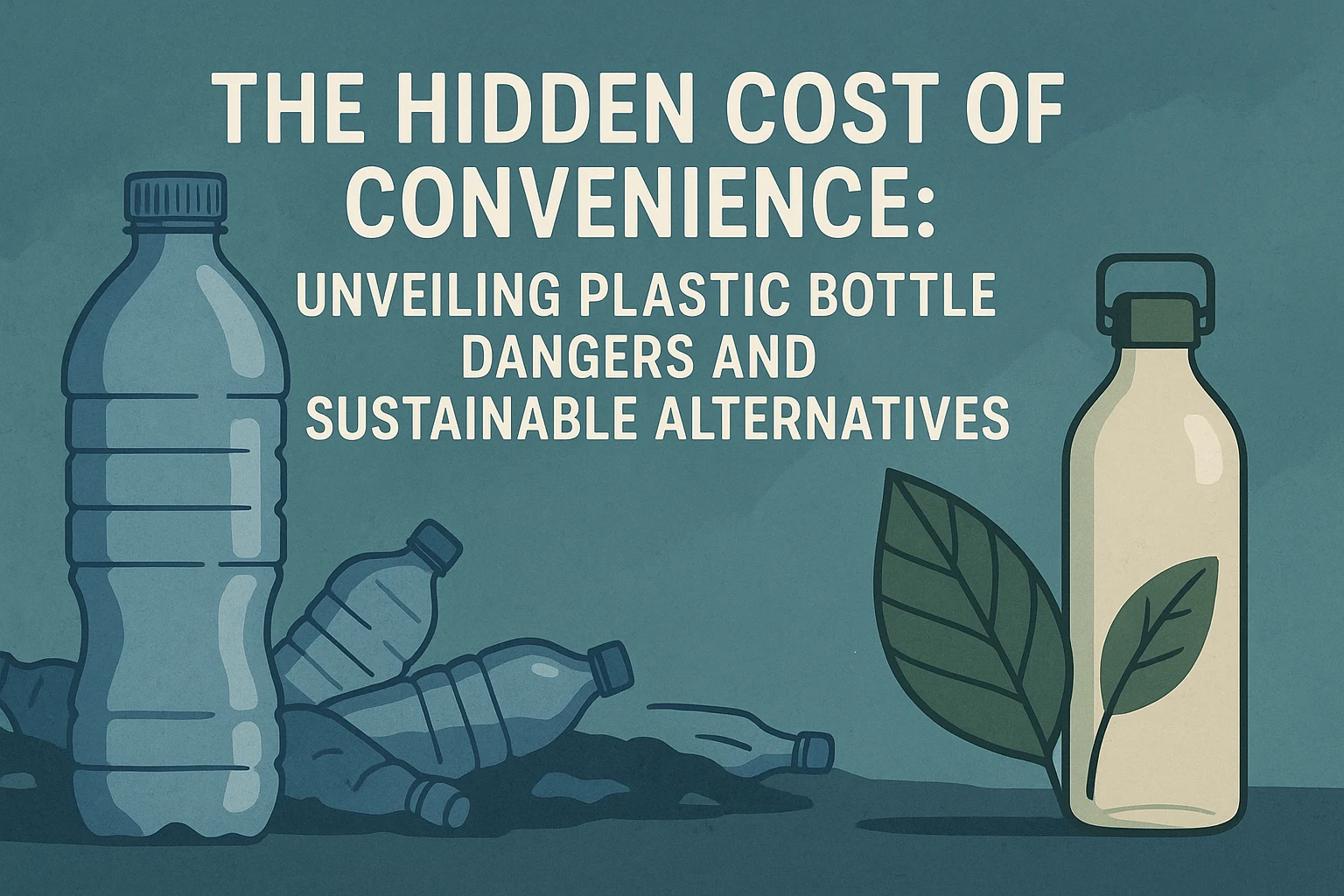The Hidden Cost of Convenience: Why Your Plastic Bottle Isn’t Just Water
That seemingly harmless plastic bottle you grab on the go might be costing you more than you think, both for your health and the planet. While undeniably convenient, single-use plastic bottles carry a surprising array of inherent dangers and an often-overlooked environmental burden. This article delves into the hidden risks, from chemical leaching and microplastic contamination to the far-reaching environmental consequences, and offers actionable alternatives for a healthier you and a happier planet.
Hidden Health Risks: Beyond Pure Water
First, let’s talk about what’s in the plastic itself and what can migrate into your water. Many plastic bottles, particularly those made from polycarbonate, can leach chemicals like Bisphenol A (BPA) into the water they contain. BPA is a notorious endocrine disruptor, meaning it can interfere with your body’s delicate hormonal system. This interference has been linked to potential impacts on reproductive health, brain function, and an increased risk of certain cancers, as highlighted by the National Institute of Environmental Health Sciences. Even if a plastic bottle is labeled \”BPA-free,\” it’s not always a guarantee of safety. These alternatives often contain similar chemicals, such as BPS or BPF, which can exhibit comparable endocrine-disrupting effects, according to research published in Environmental Health Perspectives.
Beyond BPA and its cousins, other chemicals known as phthalates are commonly used to make plastics more flexible and durable. These compounds have also been found to leach into bottled water. Like BPA, phthalates are endocrine disruptors and have been associated with developmental and reproductive issues, a concern noted by the U.S. Environmental Protection Agency. The risk of these chemicals leaching into your drink increases the longer water sits in a plastic bottle, especially when exposed to heat, such as when left in a warm car or direct sunlight. A study in Environmental Science and Pollution Research underscored this thermal influence on chemical migration.
But the concerns don’t stop at chemical leaching. A growing body of research reveals that bottled water frequently contains microplastics – tiny plastic particles that break off from the bottle itself or from processing equipment. A groundbreaking study by Orb Media and the State University of New York found alarming microplastic contamination in 93% of bottled water samples from major brands. Concentrations ranged significantly, from zero to over 10,000 particles per liter, as reported by Orb Media. While the long-term health effects of ingesting these microscopic plastic fragments are still being thoroughly researched, their pervasive presence raises significant questions about the true purity and safety of bottled water.
The Alarming Ripple Effect: From Our Bodies to Our Beaches
The journey of a single-use plastic bottle doesn’t end when you toss it in the bin; its ripple effect extends far and wide, impacting our ecosystems, wildlife, and even our own well-being through a pervasive threat: plastic pollution. The environmental impact of plastic bottles is a global crisis, and understanding its scope brings the issue from an abstract problem to a deeply personal concern.
Our oceans, in particular, bear the overwhelming brunt of plastic pollution. Every year, an estimated 11 million metric tons of plastic waste enter aquatic ecosystems, with single-use plastic bottles being a significant and identifiable contributor, according to research published in Nature. This plastic doesn’t just disappear; it fragments into smaller and smaller pieces, eventually becoming microplastics and even nanoplastics. These tiny particles are virtually impossible to remove from marine environments once they are introduced, creating a persistent and growing problem.
The consequences for wildlife are devastating. Marine animals, ranging from microscopic zooplankton to majestic whales, frequently mistake plastic debris for food. Ingestion of plastic can lead to internal injuries, blockages, starvation, and ultimately, death, as documented by National Geographic. Furthermore, entanglement in larger plastic waste, such as discarded plastic bottle rings or fishing gear, causes severe injuries, strangulation, and drowning for countless marine species, including seals, sea turtles, and seabirds, a threat highlighted by the World Wildlife Fund. The pervasive presence of plastic in these creatures disrupts entire food webs, with potential cascading effects throughout delicate marine ecosystems.
But the ripple effect doesn’t stop at the ocean’s edge. Microplastics are now found virtually everywhere: in our soil, in the air we breathe, in the food we eat, and even in our drinking water. Studies have detected microplastics in tap water around the world, as revealed by Orb Media, and they’ve been found in common food items like seafood, table salt, and honey, according to Environmental Science & Technology. Most alarmingly, microplastics have even been identified within human organs, including the lungs, liver, and kidneys, as well as in human blood and placenta, a discovery reported in Environmental International. While the full long-term health implications of microplastic ingestion are still being rigorously researched, their ubiquitous presence is a clear and unsettling sign that the plastic waste we generate is indeed coming back to us. This alarming cycle underscores why reducing our reliance on single-use plastics, particularly plastic bottles, is not just an environmental issue, but a fundamental matter of human health and the health of the entire planet.
Sip Smarter, Live Better: Easy Alternatives for a Healthier You and a Happier Planet
The good news amidst these concerns is that making a positive change is far easier than you might think. By embracing simple yet effective alternatives to plastic water bottles, you can significantly reduce your environmental footprint, protect your health, and even save money in the long run. It’s time to empower yourself and confidently declare, “I don’t use plastic water bottles!”
Here are actionable, accessible solutions to help you sip smarter and live better:
- Invest in a Reusable Water Bottle: This is the most impactful and straightforward step you can take.
Stainless Steel: These bottles are incredibly durable, lightweight, and excellent at maintaining the temperature of your beverage, whether hot or cold. Many models come with double-wall insulation for extended temperature retention.
Glass: A pure and inert option that doesn’t leach chemicals or retain flavors from previous drinks. However, it’s typically heavier and more fragile. Look for bottles with silicone sleeves for added protection against breakage.
BPA-Free Plastic (Reusable Grade): If you prefer plastic for its lightweight and shatterproof qualities, ensure it’s made from high-quality, durable, and certified BPA-free plastics specifically designed for repeated use. Always check for proper recycling symbols; generally, #2 HDPE (High-Density Polyethylene) or #5 PP (Polypropylene) are considered safer for reuse than #1 PET (Polyethylene Terephthalate) or #7 PC (Polycarbonate), which can contain BPA or similar concerning chemicals, as advised by BreastCancer.org. - Filter Your Tap Water: Tap water is often just as safe, and frequently safer, than plastic bottled water, particularly in developed nations where it is rigorously regulated by government agencies like the EPA in the U.S. (U.S. Environmental Protection Agency). Filtering can further enhance taste and remove specific impurities you might be concerned about.
Pitcher Filters: Brands like Brita or Pur offer convenient pitcher filters that remove chlorine, sediment, and other impurities, significantly improving taste.
Faucet-Mounted Filters: These systems attach directly to your kitchen tap, providing filtered water on demand with the flip of a switch.
Whole-House Filtration Systems: For the most comprehensive solution, consider installing a system that filters all the water entering your home, addressing concerns for drinking, bathing, and cooking.
Reusable Water Filter Bottles: Some reusable bottles come with built-in filters, making them perfect for travel, hiking, or refilling from various public sources while ensuring water quality. - Make it a Habit: Consistency is key to sustainable change.
Keep it Handy: Place your reusable bottle by your keys, in your bag, or in your car so you never leave home without it.
Refill Often: Actively identify water fountains, public hydration stations, or cafes that offer free refills in your area. Many public spaces, airports, and businesses are increasingly providing these amenities.
Lead by Example: Encourage friends, family, and colleagues to make the switch. Your actions can inspire others to adopt more sustainable and healthier hydration habits. - Consider the Cost Savings: While there’s an initial investment in a quality reusable bottle and filter, these items will save you significant money over time. Bottled water can cost thousands of times more per gallon than tap water, a stark comparison highlighted by the Natural Resources Defense Council. Over a year, these savings can accumulate considerably, proving that choosing health and planet doesn’t have to break the bank.
By embracing these simple yet powerful alternatives, you’re not just choosing a healthier hydration method for yourself; you’re actively contributing to a happier, healthier planet for everyone. Make the switch today and be a vital part of the solution!
📚 Resources
- BreastCancer.org – Plastic and Cancer Risk
- Earth Day – Plastics Facts
- Environmental Health Perspectives – BPA-replacement chemicals in thermal paper
- Environmental International – Microplastics in human blood: A study on the presence of PE, PP, PS, and PMMA
- Environmental Science and Pollution Research – Microplastic release from plastic bottles under thermal stress
- Environmental Science & Technology – Microplastics in bottled water: A global overview
- National Geographic – Plastic Pollution
- National Institute of Environmental Health Sciences – Bisphenol A (BPA)
- Natural Resources Defense Council – Bottled Water: Pure Drink or Pure Hype?
- Nature – The global plastic waste crisis
- Orb Media – Plus Plastic: Microplastics found in bottled water
- Orb Media – Tap Water Microplastics: A global investigation
- UN Environment Programme – Beat Plastic Pollution
- U.S. Environmental Protection Agency – What are Phthalates?
- U.S. Environmental Protection Agency – Safe Drinking Water Act (SDWA)
- World Wildlife Fund – Plastic Pollution

